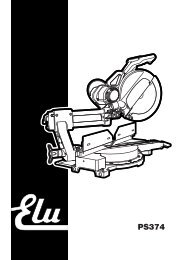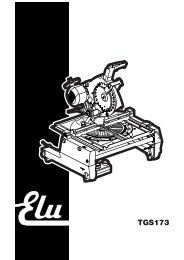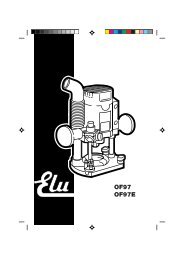Instruction Manual (English) - Service - Dewalt.no
Instruction Manual (English) - Service - Dewalt.no
Instruction Manual (English) - Service - Dewalt.no
You also want an ePaper? Increase the reach of your titles
YUMPU automatically turns print PDFs into web optimized ePapers that Google loves.
ENGLISH• To set for 11 mm, loosen the fence clamping k<strong>no</strong>bs (109) and slide thefence (113) out of the clamping support (114).• Turn the fence and re-engage the clamping support in the slot asshown (fi g. P5).• To use with the full height of 75 mm, slide the fence into the clampingsupport with the wide face in the vertical position (fi g. P4).WARNING: Use the 11 mm profile for ripping low workpiecesto allow access between the blade and the fence for the pushstick. The rear end of the fence should be level with the front ofthe riving knife.Mounting and adjusting the mitre fence (fig. Q1 - Q4)The mitre fence (D271052) is available as an option. The mitre fence (41) canbe used for mitre cutting when the machine is in saw bench mode (fi g. Q1).• Loosen the clamp k<strong>no</strong>b (115) and swing the guide bar (116) out (fi g. Q2).Tighten the clamp k<strong>no</strong>b.• Slide the fence on the left side on the table (fi g. Q3).• Loosen the lock k<strong>no</strong>b (117).• Place a square (82) against the fence (41) and the blade (76).• If adjustment is required, proceed as follows:• Loosen the nut (118) a few turns and turn the right angle adjustmentstop screw (119) (fi g. Q4) in or out until the fence is at 90° to the bladeas measured with the square (fi g. Q3).• Tighten the k<strong>no</strong>b (117).• Check that the pointer (120) indicates zero on the scale (121).Adjust if necessary.Changing from saw bench to mitre saw mode (fig. A3, E & M1)• Remove the parallel fence (22), or the mitre fence, if fi tted (fi g. A3).• Remove the upper blade guard (21).• Replace the under-table guard (63) (fi g. E).• Proceed as described in the section “Turning the sawhead and tableover”.• Slacken the riving knife clamp k<strong>no</strong>b (97) and remove the riving knife (20),while holding the blade guard (8) (fi g. M1).• Lower the blade guard.• Place the riving knife in its storage position in the inside of the base.OPERATION<strong>Instruction</strong>s for UseWARNING: Always observe the safety instructions andapplicable regulations.• Ensure the material to be sawn is firmly secured in place.• Apply only a gentle pressure to the tool and do <strong>no</strong>t exert sidepressure on the saw blade.• Avoid overloading.The attention of UK users is drawn to the “woodworking machinesregulations 1974” and any subsequent amendments.Ensure the machine is placed to satisfy your ergo<strong>no</strong>mic conditions in termsof table height and stability. The machine site shall be chosen so that theoperator has a good overview and e<strong>no</strong>ugh free surrounding space aroundthe machine that allows handling of the workpiece without any restrictions.To reduce effects of vibration make sure the environment temperature is <strong>no</strong>ttoo cold, machine and accessory is well maintained and the workpiece sizeis suitable for this machine.Prior to operation:• Install the appropriate saw blade. Do <strong>no</strong>t use excessively worn blades.The maximum rotation speed of the tool must <strong>no</strong>t exceed that of thesaw blade.• Do <strong>no</strong>t attempt to cut excessively small pieces.• Allow the blade to cut freely. Do <strong>no</strong>t force.• Allow the motor to reach full speed before cutting.• Make sure all locking k<strong>no</strong>bs and clamp handles are tight.Switching on and off (fig. A1, R1 - R3)This machine has two independent switching systems. In mitre saw mode,the trigger switch (11) is used (fi g. R1). In saw bench mode, the on/offswitch (1) is used (fi g. R2). Integrated in the switch box is a motor overloadprotector with manual reset. In case of a power shut-off, proceed asfollows:- Make sure the machine has been switched off.- Press the reset button (142).Mitre saw mode (fig. R1)A hole (122) is provided in the trigger for insertion of a padlock to lock theswitch.• To run the tool, press the trigger switch (11).• To stop the tool, release the switch.Saw bench mode (fig. R2 & R3)The on/off switch offers multiple advantages:- <strong>no</strong>-volt release function: should the power be shut off for some reason,the switch has to be deliberately reactivated.- extra safety: the hinged safety enclosure plate (123) can be locked bypassing a padlock through the holes (124 & 125). The plate also servesas an “easy to locate” emergency stop button as pressure on the frontof the plate will depress the stop button.• To switch the machine on, press the green start button (126).• To switch the machine off, press the red stop button (127).Locking the switches• In order to avoid unauthorised use of the machine, lock both switchesusing padlocks.Basic saw cutsSawing in mitre saw modeIt is dangerous to operate without guarding. Guards must be in positionwhen sawing.• Make sure that the under-table guard does <strong>no</strong>t become clogged withsawdust.• Always clamp the workpiece when cutting <strong>no</strong>n-ferrous metals.General handling- In the mitre saw mode, the sawhead is automatically locked in theupper “park”-position.- Squeezing the guard release lever will unlock the sawhead. Moving thesawhead down retracts the movable lower guard.- Never seek to prevent the lower guard returning to its park positionwhen the cut is completed.- The minimum length of offcut material is 10 mm.- When cutting short material (min. 190 mm to the left or the right of theblade), the use of the optional material clamp is recommended.- When cutting UPVC sections, a supporting piece made out of timberwith a complementary profi le should be placed beneath the materialbeing cut to provide the correct level of support.Clamping the Workpiece (fig. A5, Z)WARNING: A workpiece that is clamped, balanced and securebefore a cut may become unbalanced after a cut is completed.An unbalanced load may tip the saw or anything the saw isattached to, such as a table or workbench. When making a cutthat may become unbalanced, properly support the workpieceand ensure the saw is firmly bolted to a stable surface. Personalinjury may occur.WARNING: The clamp foot must remain clamped above thebase of the saw whenever the clamp is used. Always clamp theworkpiece to the base of the saw – <strong>no</strong>t to any other part of thework area. Ensure the clamp foot is <strong>no</strong>t clamped on the edge ofthe base of the saw.21
















